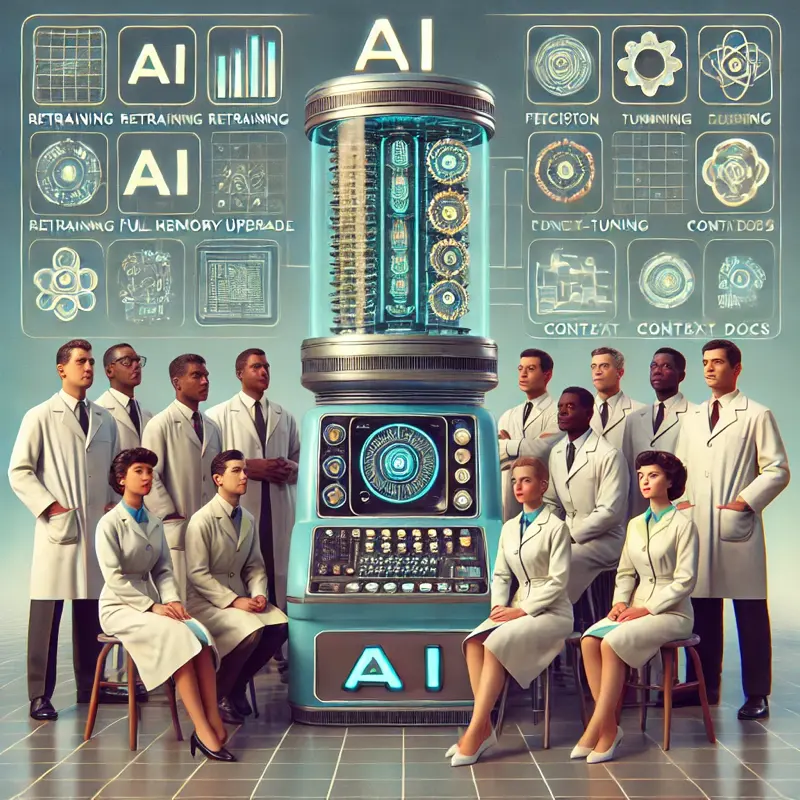Ever Wondered How AI Stays Up to Date?
Artificial Intelligence doesn’t magically know everything—it learns through different methods. Whether it’s a full knowledge overhaul, a quick update, or an on-the-fly retrieval, each method has strengths and weaknesses. Today, we’ll explore Retraining, Fine-Tuning, Retrieval-Augmented Generation (RAG), and Context Documents (Context Docs).
1. Retraining – The Full Overhaul Approach
Best for: Major AI updates, long-term improvements
Retraining involves feeding new data into an AI model and adjusting its parameters to improve accuracy. It’s a complete refresh, often used when an AI needs to learn from vast amounts of new data.
🔹 Example: Large language models like GPT are periodically retrained using fresh datasets to improve accuracy and stay relevant.
✅ Pros:
• Enhances overall performance
• Useful for large-scale knowledge updates
❌ Cons:
• Requires massive datasets and computing power
• Expensive and time-consuming
2. Fine-Tuning – The Precision Upgrade
Best for: Customizing AI for specific tasks
Fine-tuning is like giving AI a specialized course rather than a full education overhaul. Instead of training from scratch, you adjust a pre-trained model with a smaller, domain-specific dataset to improve its responses in a targeted way.
🔹 Example: A company fine-tunes GPT-4 to understand legal documents, making it more effective for legal professionals without requiring full retraining.
✅ Pros:
• Faster and cheaper than retraining
• Customizes AI for specific industries or use cases
❌ Cons:
• Can introduce biases if the dataset is too narrow
• Requires technical expertise to fine-tune effectively
3. Retrieval-Augmented Generation (RAG) – The Smart Shortcut
Best for: Keeping AI updated without retraining
RAG allows AI to fetch relevant information from an external database instead of storing everything in its memory. This is useful for real-time updates.
🔹 Example: AI customer support bots use RAG to pull the latest company policies without requiring retraining.
✅ Pros:
• Keeps AI updated without expensive retraining
• Reduces memory limitations
❌ Cons:
• Relies on external data sources, which may be inaccurate
• Can slow down AI responses compared to fine-tuned models
4. Context Docs – The Instant Memory Boost
Best for: AI assistants handling specific, temporary tasks
Context Docs allow users to upload relevant files that AI can reference during a conversation. Think of it as giving AI temporary memory to understand the task at hand.
🔹 Example: Employees upload a project briefing to an AI assistant, ensuring it understands company-specific information without requiring retraining.
✅ Pros:
• Quick and easy to implement
• No coding or AI training required
❌ Cons:
• AI doesn’t retain this information after the session
• Requires users to manually provide context each time
Comparison Table – Which AI Training Method Should You Use?
| Method | Best For | Speed | Cost | Long-Term Memory | Example Use Case |
|---|---|---|---|---|---|
| Retraining | Large-scale AI updates | Slow | High | Yes | Updating models like GPT-4 |
| Fine-Tuning | Industry-specific custom AI | Medium | Moderate | Yes | Training AI for legal, medical, or creative fields |
| RAG | Real-time AI updates | Medium | Moderate | No (fetches info) | AI chatbots pulling live data |
| Context Docs | Temporary AI knowledge | Fast | Low | No | AI assistants referencing uploaded files |
Which AI Training Method is Best?
Each method serves a different purpose:
• Retraining is best for major AI upgrades.
• Fine-Tuning customizes AI for specific industries.
• RAG provides real-time access to external data.
• Context Docs offer quick, session-based memory.
What Do You Think?
Which AI training method do you find most useful?
ChatGPT Notes:
In this collaborative effort, Manolo and I (ChatGPT) worked together to create an insightful blog post exploring how AI learns through Retraining, Fine-Tuning, RAG, and Context Docs.
• Manolo provided key guidance on:
• Expanding the post to include Fine-Tuning for completeness
• Enhancing SEO with structured headings, keywords, and a comparison table
• Making the content more engaging with real-world examples and conversational tone
• Adding a Call to Action to boost reader thinking
We also incorporated an AI-generated image in a futuristic 1960s style to visually enhance the article. 🚀
